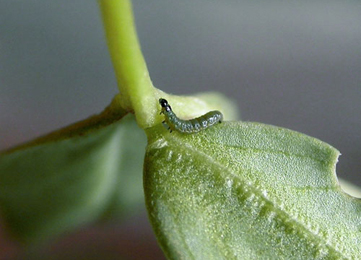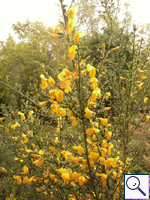|
||||||
|
CYTISUS. Brooms. [Fabaceae] |
|
|
Five species of Cytisus are recorded in Britain. These include the native Broom (C. scoparius), Prostrate Broom (C. scoparius maritiumus) and Pineapple Broom (C. battandieri). Ten British miners are recorded on Cytisus. A key to the European miners recorded on Cytisus is provided in Bladmineerders van Europa. |
|
Key for the identification of the known mines of British |
1a > Leaf-miner and case-bearer: The larva lives outside the mine, protected by a case, and feeds on the underlying plant tissues via a hole cut in the epidermis. From that point it eats away as much leaf tissue as it can reach without fully entering the mine. Mine does not contain frass (Coleophora species). |
1b > Leaf, twig or bark miner, but not a case-bearer: The larva lives mainly inside the mine. Mine usually contains frass. In later instars the larva may live sandwiched between two more or less circular sections cut from the leaf. |
2 > Leaf-miner and case-bearer: Very untidy, bivalved, lobe case of 7-8 mm. The mouth angle is 90°, causing the case to be perpendicular to the leaf. |
|
Coleophora saturatella Stainton, 1850 [Lepidoptera: Coleophoridae]. |
3a > Bark-miner: A gallery in the bark of the food plant generally mining upwards, similar to that of Trifurcula immundella, which usually mines downwards. The mines are very hard to detect, but in late spring, the small white pupal cocoons are easy to spot among the dark stems. |
|
Leucoptera spartifoliella (Hübner, 1813) [Lepidoptera: Lyonetiidae]. |
3b > Twig-miner: Forms an inflated mine in the green bark of a twig, 15 - 25 mm long. The mine turns brown/grey and is found near to the end of a twig, often on a small plant. |
|
Phyllonorycter scopariella (Fabricius, 1781) [Lepidoptera: Gracillariidae]. |
3c > Twig-miner: A long black straight gallery which passes down the twig initially. The mine then changes direction and the spaces between the ridges stain black as the mine fills them. The branches may appear stained black as the mines develop. The larva is yellow.. The larva mines not in leaves, but under the bark of twigs of broom (Sarothamnus scoparia). The mine is visible as a dark gallery, but is easily confused with the similar mine of Leucoptera spartifoliella (UK Moths). |
|
Trifurcula immundella (Zeller, 1839) [Lepidoptera: Nepticulidae]. |
3d > Leaf-miner |
4a > Leaf-miner: An irregular whitish, linear mine, frass in conspicuous black strips (Spencer, 1972b: 72 (fig. 235), 77; Spencer, 1976: 409 (fig. 717), 410). Wide corridor, generally upper-surface but not rarely, partly or entirely, lower-surface. Primary feeding lines distinct. Frass at first in grains, later in short thread fragments to two close rows along the sides. Pupation outside the mine. An irregular, whitish gallery, usually upper side, but sometimes starting lower side. Frass conspicuous. |
|
Phytomyza cytisi Brischke, 1880 [Diptera: Agromyzidae]. |
4b > Leaf-miner: An initially linear leaf-mine, normally adjoining leaf-margin and running towards apex of leaf, then turning and widening into a blotch in the area of the mid-rib (Spencer, 1972b: 40, fig. 123; Spencer, 1976: 117, fig. 190). Hooklike, upper-surface corridor. The corridor begins near the base of a leaflet, runs along the margin to the tip, then, quickly widening, redescends over the midrib towards the base of the leaflet. Frass in the corridor part in fine grains, further up in small clumps. Pupation outside the mine. Older mines turn black and then are somewhat easier to find. A narrow corridor along the leaf edge, turning and making a blotch in the midrib area. Puparium reddish-orange |
|
Agromyza johannae Meijere, 1924 [Diptera: Agromyzidae]. |
4c > Leaf-miner: A narrow linear mine adjoining the leaf margin in the first instar, which later develops into an irregular blotch with conspicuous lumps of greenish frass (Spencer, 1976: 302). The first instar larva makes a narrow upper-surface corridor along the leaf margin. After it has moulted it begins a large upper-surface blotch. Frass in conspicuous green lumps, that can run out irregularly. Pupation outside the mine. Forms a narrow linear mine by the margin of the leaf which later develops into a blotch. The blotch has clumps of greenish frass. |
|
Phytoliriomyza variegata (Meigen, 1830) [Diptera: Agromyzidae]. |
4d> Leaf-miner: The first generation initially forms an unmistakable leaf-mine on Anthyllis vulneraria, but the second generation feeds on the flowers. Feeding signs on other plants vary in appearance. Larvae can move between sewn leaves, and more than one larva may be found together. Larvae in a small full depth blotch, often with extensions. Frass concentrated in one corner of the mine. The mining activities may cause the leaf to roll inwards. Older larvae live free among spun leaves, but still they may make then full depth mines by feeding on the leaf tissue from a small opening. |
 Aproaerema anthyllidella larva, dorsal Image: © Steve Wullaert (Bladmineerders van Europa) |
| On Anthyllis, Medicago, Onobrychis, Ononis and Trifolium, but not yet on Cytisus, in Britain and Anthyllis, Chamaecytisus, Coronilla, Cysisus, Dorycnium, Galega, Glycine, Hymenocarpos, Lathyrus, Lotus, Medicago, Melilotus, Onobrychis, Ononis, Ornithopus, Oxytropis, Phaseolus, Psoralea, Trifolium, Trigonella and Vicia elsewhere. Britain including the Channel Is. and Northern Ireland. Also recorded in the Republic of Ireland. Widespread in continental Europe. |
Aproaerema anthyllidella (Hübner, 1813) [Lepidoptera: Gelechiidae]. |
4e > Leaf-miner: An irregular gallery filled with greenish frass, leading to a circular or oval blotch with blackish frass arranged in a spiral fashion. The very first part of the mine is a densely contorted corridor of about 2 mm long, that quickly turns brown. It is followed by a more or less straight corridor of c. 10 mm, entirely filled with greyish green frass. This suddenly widens into a round blotch that during its expansion overruns the earlier corridor and in the end may occupy half of a Laburnum leaflet. The frass, greenish at first, black later, is deposited in the bloth in roughly concentric arcs, glued to the upper epidermis. Pupation external, exit slit in upper epidermis. |
|
|
4f > Leaf-miner: Upper-surface tentiform mine (according to Hering, 1957a, mostly lower-surface in Laburnum). The mine is strongly contracted, almost folding the leaflet to a pod and concealing the mine. Pupa in the mine in a flimsy cocoon. Frass in a corner of the mine. |
|
Phyllonorycter staintoniella (Nicelli, 1853) [Lepidoptera: Gracillariidae]. |
| Last updated 03-Jul-2019 Brian Pitkin | ||

